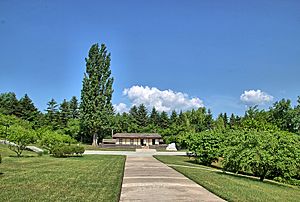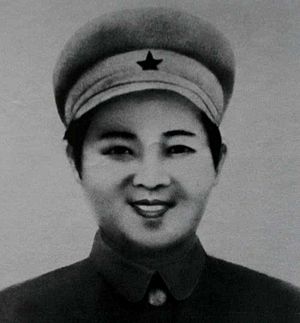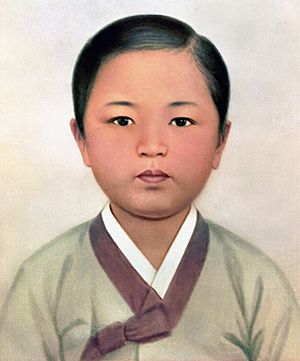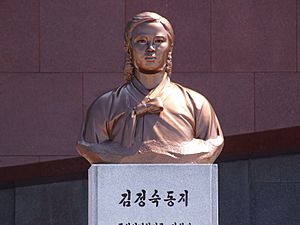Kim Jong-suk facts for kids
Quick facts for kids
Kim Jong-suk-dik
|
|
|---|---|
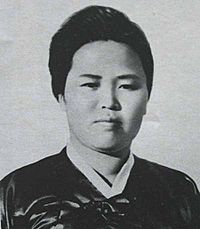 |
|
| Born | 24 December 1917 Osan-dong, Hoeryong, North Hamgyong, Japanese Korea
|
| Died | 22 September 1949 (aged 31) |
| Spouse(s) | Kim Il-sung (1941–1949) |
| Children | Kim Jong-il Kim Man-il Kim Kyong-hui |
Kim Jong-suk (born December 24, 1917 – died September 22, 1949) was an important figure in North Korean history. She was a brave fighter against the Japanese during their rule over Korea. She was also a Communist activist. Kim Jong-suk was the second wife of Kim Il-sung, who became the first leader of North Korea. She was also the mother of former leader Kim Jong-il and the grandmother of the current leader, Kim Jong-un.
Contents
Kim Jong-suk's Early Life and Family
Kim Jong-suk was born on December 24, 1917. Her birthplace was in Hoeryong County, which is in the North Hamgyong Province of Japanese Korea.
When she was young, Kim Jong-suk traveled to Manchuria with her mother. They were looking for her father, but they found out he had already passed away there. Soon after, her mother also died, and Kim Jong-suk became an orphan.
Joining the Guerrilla Fighters
Most historical records show that Kim Jong-suk joined Kim Il-sung's group of guerrilla fighters. This happened around 1935 or 1936. She first worked as a kitchen helper for the group.
However, some reports say that Kim Jong-suk joined the fighters after her mother and her elder brother's wife were killed by the Japanese.
During this time, Kim Jong-suk did many different jobs. She was even arrested by the Japanese in 1937. This happened when she was trying to get food and supplies secretly for the group. After she was released, she went back to the guerrillas. There, she helped by cooking, sewing, and washing clothes.
It is said that Kim Jong-suk saved Kim Il-sung's life around this period.
Family Life and Children
Kim Jong-suk married Kim Il-sung in the Soviet Union. This likely happened in 1941. On February 16, 1941, in a Soviet village called Vyatskoye, Kim Jong-suk gave birth to their first son, Kim Jong-il.
Later, in 1944, she had a second son named Kim Man-il. In 1946, she gave birth to their daughter, Kim Kyŏng-hŭi.
First Lady of North Korea
The Democratic People’s Republic of Korea (DPRK) was established in 1948. A year later, and until her death, Kim Jong-suk became the first lady of North Korea.
People who knew her described Kim Jong-suk as a "small, quiet woman." They said she wasn't very educated, but she was friendly and enjoyed life. A Soviet officer named Major General N.G. Lebedev remembered her. He said Kim Jong-suk was "a lively and kind lady." She would always cook a lot of food for the hungry Soviet generals when they visited Kim Il-sung's home.
Kim Jong-suk's Death and Legacy
Kim Jong-suk passed away in Pyongyang in 1949. The official story from North Korea is that she died because of the difficult life she had as a guerrilla fighter. However, her death is not mentioned in her official biography.
After Kim Il-sung's son, Kim Jong-il, became the leader, he started a campaign. This campaign aimed to make his mother, Kim Jong-suk, into a "revolutionary immortal." This means she was presented as a hero of the revolution.
Even though she was described as a quiet woman, this campaign made Kim Jong-suk seem like a "great strategist." It also said she gave "on-the-spot guidance" to people. In her hometown of Hoeryong, there is a museum, a library, a statue, and a square dedicated to her. Her childhood home is also preserved. These places honor her as the 'Mother of Korea'. It is also said that she organized parachute training and won many shooting contests.
Awards and Honors
Kim Jong-suk received several important awards:
 Hero of the Republic, given on September 21, 1972 (after her death).
Hero of the Republic, given on September 21, 1972 (after her death). Order of the National Flag (1st Class with Neck Chain).
Order of the National Flag (1st Class with Neck Chain).
Images for kids
-
Kim Jong-suk is seen as the mother of Kim Jong-il in North Korea. Kim Il-sung and Kim Kyong-hui are also pictured.
See also
 In Spanish: Kim Jong-suk para niños
In Spanish: Kim Jong-suk para niños


